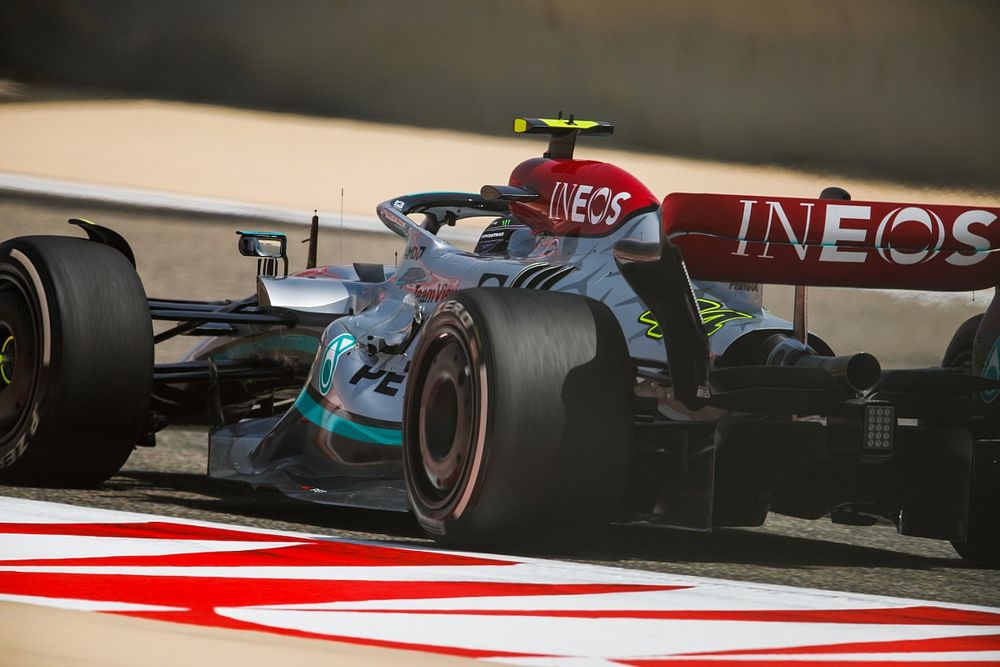Mercedes ‘spaceship’ mirrors prompt Ferrari calls for F1 rules clampdown
Ferrari has called for a clampdown on Formula 1's mirror design regulations, amid fears that Mercedes’ new concept could trigger wild ‘spaceship’ designs.

Zak Mauger / Motorsport Images
As part of the sidepods overhaul that Mercedes introduced on its W13 for this week’s Bahrain test, the Brackley-based outfit reworked the arrangement surrounding its mirrors.
This included heavily sculpted mounts to help feed vanes on the cockpit side impact structures.
Ferrari team principal Mattia Binotto suggested that the Mercedes approach was questionable, because the mirror design was not supposed to exploit any aerodynamic advantage.
“On the mirrors, I am somehow surprised,” said Binotto, when asked by Autosport for his thoughts on the Mercedes changes.
“I find them quite surprising, and it is something that we are not expecting. I think in the spirit of that, it is something that I think for the future needs to be addressed.
“Already in the past we always argue the mirrors should not have any aero purpose. They should be there just to look behind.
“I think that the way that they have designed their car, certainly there is a significant aero purpose in the mirrors itself. I think it is something that we need to stop for the future, no doubts, because the risk is that we will come in the future, that all the teams will start designing mirrors, that will look like spaceships.
“I don't think that's what we are looking for as F1.
“I'm not arguing [against] the idea. I think they found a solution that is interesting, but I think in the spirit of what we intend to do, certainly for the future, it is something that we need to discuss.”

Mercedes W13 mirror
Photo by: Giorgio Piola
While Binotto has questions about the Mercedes mirrors, he says he has no issues with the way the sidepods have been designed.
“I think first, looking at the Mercedes car, no doubt it's a great car,” he said. “Good concept, quite different to the one we got.
“I think what is interesting is the layout and the sidepods again. On the legality overall, I don't think that we can have any 'doubt’.
“It has gone through a process and the FIA is certainly the one which is responsible for policing and making sure it's fully legal. And I don't think Mercedes is doing something illegal as well.”
What F1’s mirror rules say
F1 teams have long looked to manipulate the design and location of the wing mirrors, as they are a mandatory requirement in an important area of the car from an aerodynamic point of view.
However, F1’s rules are clear that the mirror designs should be purely structural and not be designed in such a way to boost aero.
Under F1’s technical regulations, the mirrors are actually excluded from specific bodywork regulations.
However, that means they fall under the remit of Article 3.2.2 that means that their design must not deliver any aerodynamic benefit.
The regulation states: “The aerodynamic influence of any component of the car not considered to be bodywork must be incidental to its main function. Any design which aims to maximise such an aerodynamic influence is prohibited.”
While Binotto is concerned about the Mercedes design opening the door on teams pushing for more extreme mirror solutions, Ferrari has in the past had to row back on some of its own designs after FIA intervention.

Fernando Alonso, Ferrari F10
Photo by: Andrew Ferraro / Motorsport Images

Ferrari SF71H mirror on halo
In 2010, Ferrari, along with a few other teams, began to mount their mirror outboard of the sidepods, on top of the vertical flow conditioner.
This led to concerns about visibility and safety, given they vibrated more in this location. The FIA acted swiftly in this instance and required them to be moved back to an area beside the cockpit by the fourth round in China.
F1 teams pushed their luck again in 2018 when they decided to mount their wing mirrors on the side of the halo. This in of itself was not considered an issue but the addition of some eyebrow-like winglets above the wing mirrors, which clearly served an aerodynamic function, caused alarm.
The FIA permitted the eyebrow-like winglets for use at the Spanish Grand Prix but subsequently banned their use there onwards.
The two-piece mirror body that formed part of that design have been on the cars since 2017. They serve as an interesting aerodynamic function that many of the teams have picked up on since and have reworked into their 2022 designs.
This is a function of how the regulations have been written, with teams cleverly readapting what is defined as the ‘mirror stalk’ within the regulations.

Yuki Tsunoda, AlphaTauri AT03
Photo by: Mark Sutton / Motorsport Images

Mercedes W13 chassis canards
Photo by: Giorgio Piola
The two most interesting designs in this respect are the AlphaTauri and Mercedes designs, both of which have a series of vortex generators mounted on the outer edge of the sidepod to help with controlling the airflow in that region in combination with the mirrors.
Be part of the Autosport community
Join the conversationShare Or Save This Story
Subscribe and access Autosport.com with your ad-blocker.
From Formula 1 to MotoGP we report straight from the paddock because we love our sport, just like you. In order to keep delivering our expert journalism, our website uses advertising. Still, we want to give you the opportunity to enjoy an ad-free and tracker-free website and to continue using your adblocker.



















Top Comments